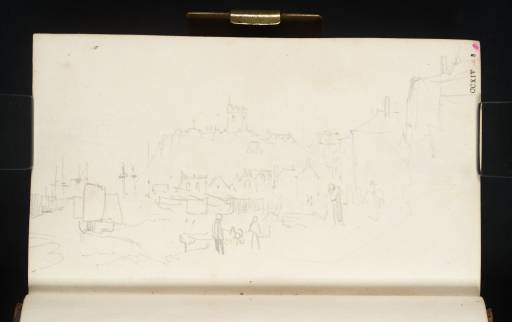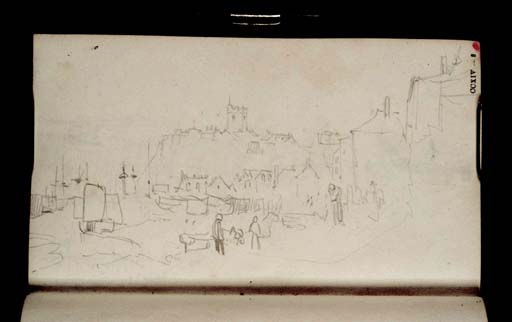Joseph Mallord William Turner Folkestone Harbour, with Boats and Figures, below St Mary and St Eanswythe's Church 1825
Image 1 of 2
Joseph Mallord William Turner,
Folkestone Harbour, with Boats and Figures, below St Mary and St Eanswythe's Church
1825
Joseph Mallord William Turner 1775–1851
Folio 8 Recto:
Folkestone Harbour, with Boats and Figures, below St Mary and St Eanswythe’s Church 1825
D18855
Turner Bequest CCXIV 8
Turner Bequest CCXIV 8
Pencil on white wove paper, 95 x 155 mm
Inscribed by John Ruskin in red ink ‘8’ bottom left, descending vertically
Stamped in black ‘CCXIV – 8’ bottom left, descending vertically
Inscribed by John Ruskin in red ink ‘8’ bottom left, descending vertically
Stamped in black ‘CCXIV – 8’ bottom left, descending vertically
Accepted by the nation as part of the Turner Bequest 1856
References
1909
A.J. Finberg, A Complete Inventory of the Drawings of the Turner Bequest, London 1909, vol.II, p.651, CCXIV 8, as ‘Scene on coast. (? at Folkestone.)’.
With the page turned horizontally, the view is west along the Stade above the harbour at Folkestone, as tentatively suggested by Finberg,1 with figures and boats apparently beached at low tide, overlooked by St Mary and St Eanswythe’s Church on the cliff beyond. Nothing survives of the jumble of houses, while the port was later considerably expanded and redeveloped. Turner presumably approached on foot along the coast from Dover (see under folio two recto; D18843), as the harbour gradually comes into sight in successive views up to folio 7 recto (D18853).
For various views in and around the town see also folio 7 verso opposite, the verso, folios 9 recto–20 recto, likely folio 21 verso, folio 22 verso, likely folios 23 recto and verso, folios 281 recto–282 recto, and perhaps the verso of the latter leaf (D18854–D18879, D18881, D18883–D18889, D19397–D19400). There are a few pencil sketches in and around the town in the Richmond Hill; Hastings to Margate sketchbook of about 1816–19 (Tate D10475–D10477, D10479; Turner Bequest CXLI 34a–35, 35a, 36a), many more in the Folkestone sketchbook of about 1821–2 (see under D17235; CXCVIII 17a), and a single identified view from the sea in the France and Folkestone sketchbook of about 1826 (D24132; CCLVI 13a).
Three watercolours of a year or two prior to 1825, unfinished to varying degrees (Tate D18158, D25480, D36072; Turner Bequest CCVIII Y, CCLXIII 357, CCCLXIV 226), show Folkestone from the sea, and are catalogued in the present author’s ‘Marine Views c.1817–24’ section of this catalogue. See under folios 10 verso–11 verso (D18860–D18862) for possible connections with an undated watercolour of Fishing Boats on Folkestone Beach, Kent (National Gallery of Ireland, Dublin),2 which has been linked to the ongoing Ports of England series, and also to an unrealised ‘The English Channel, or La Manche’ project. See also Tate D17760–D17761 (Turner Bequest CCIII C, D), respectively a watercolour study and pencil outline from similar angles, with the church in the background.
As discussed in this sketchbook’s Introduction, its earlier and later pages include sketches relating to Kent watercolour subjects engraved in 1826 for the Picturesque Views on the Southern Coast of England; see folios 15 recto, 17 verso, 18 recto, 19 verso and 282 recto (D18869, D18874–D18875, D18878, D19399) in relation to Folkestone, Kent (Taft Museum of Art, Cincinnati).3 Folkestone Harbour and Coast to Dover, engraved in 1831 for the Picturesque Views in England and Wales (Yale Center for British Art, New Haven),4 appears informed by folios 12 verso, 13 verso, 14 verso and 17 recto (D18864, D18866, D18868, D18873). Both designs feature the succession of white chalk cliffs towards Shakespeare Cliff, on the near side of Dover. A loose coastal watercolour study (D25185; CCLXIII 63) has also been tentatively linked to Folkestone and the England and Wales series, although the subject is far from certain.
Around the time Turner revisited the town in 1845, using the Ideas of Folkestone sketchbook (Tate; Turner Bequest CCCLVI) for numerous atmospheric watercolours in good and bad weather, the development of the harbour was well under way, with the introduction of a spur from the new railway line from Dover, running along a low viaduct (now redundant) over the harbour to an additional pier for passenger services to France. The heavily worked oil painting known as Seascape: Folkestone (private collection)5 may date from that period, but lacks any specific landmarks.
Back in the mid 1820s Folkestone remained a relatively quiet backwater, as suggested by the wider prospect in William Daniell’s 1823 aquatint Folkestone, Kent (Tate impression: T02954) from A Voyage Round Great Britain, and by the 1814 vignette engraving after Luke Clennell for the Southern Coast (Tate impressions: T05255–T05256). Today, the immediately striking feature from this direction is a large Modernist hotel along the inner end of the harbour, to the left of the cliff and church and rising to about the same height.
Matthew Imms
September 2020
How to cite
Matthew Imms, ‘Folkestone Harbour, with Boats and Figures, below St Mary and St Eanswythe’s Church 1825 by Joseph Mallord William Turner’, catalogue entry, September 2020, in David Blayney Brown (ed.), J.M.W. Turner: Sketchbooks, Drawings and Watercolours, Tate Research Publication, March 2023, https://www


